Abstract
Eight serially transplantable human breast-cancer xenograft lines have been established in immune-suppressed mice. Specimens from 102 primary and secondary lesions obtained at surgery from 80 patients were implanted into mice immune-suppressed by thymectomy and whole-body irradiation. A number of variations of implantation site, transplantation technique, method of immune suppression and hormonal manipulation of the host were tried in an attempt to increase the take rate, but without success. The 8 lines established have been serially transplanted into further immune-suppressed mice for at least 2 passages, and appear to maintain characteristic human histopathology, chromosome number and tumour-marker production. None of the tumours show hormone sensitivity. The poor take rate may be a reflection of the biological nature of breast cancer rather than a failure of the immune-deprivation technique, as many other human tumours grow well as xenografts in this system.
Full text
PDF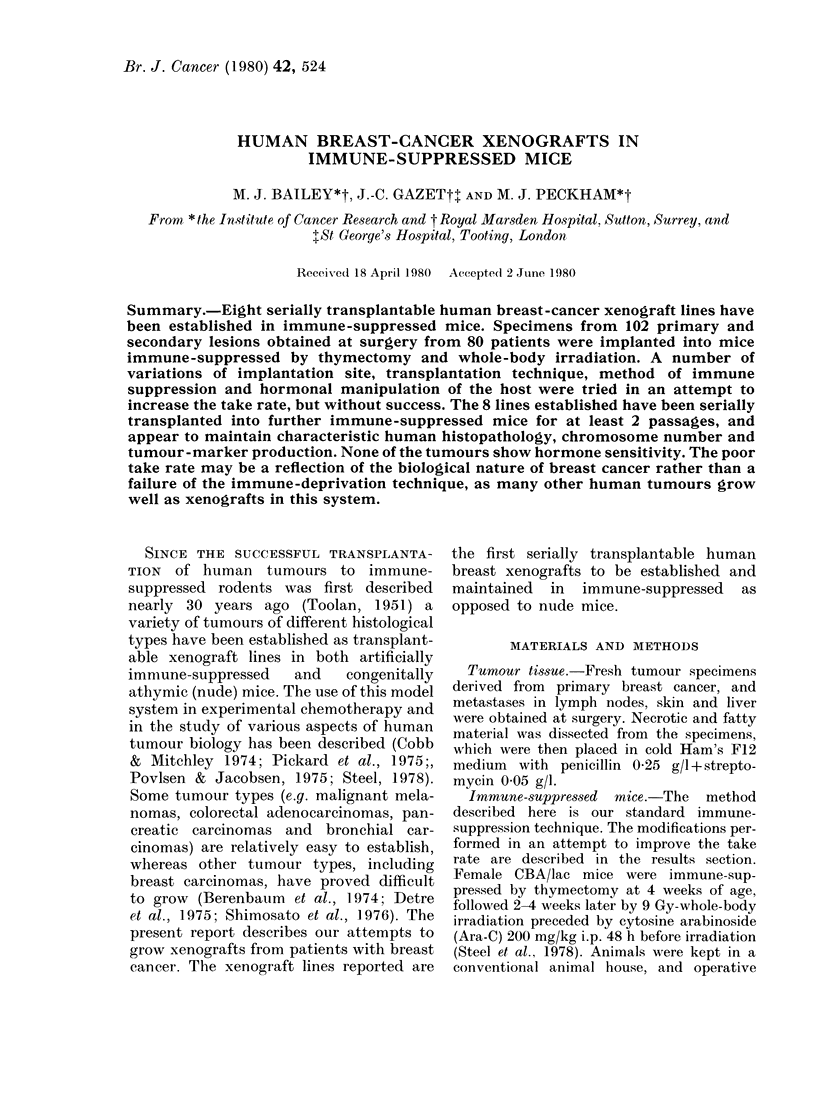
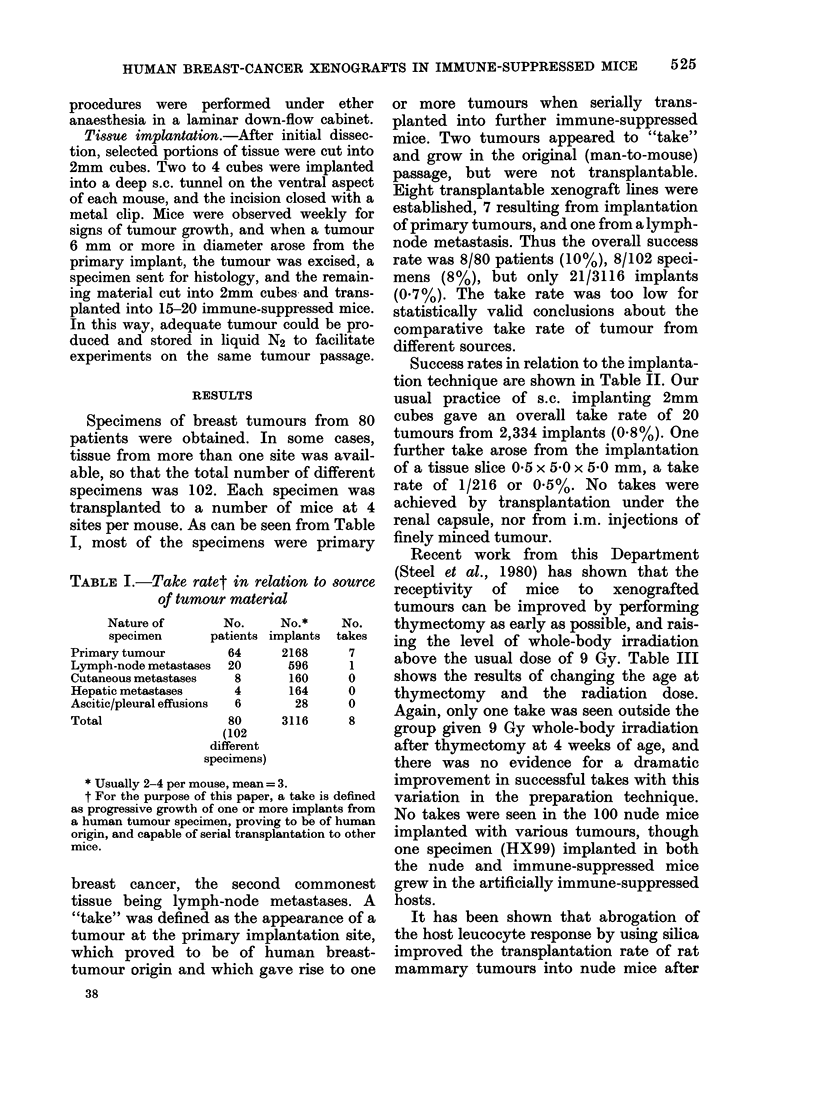

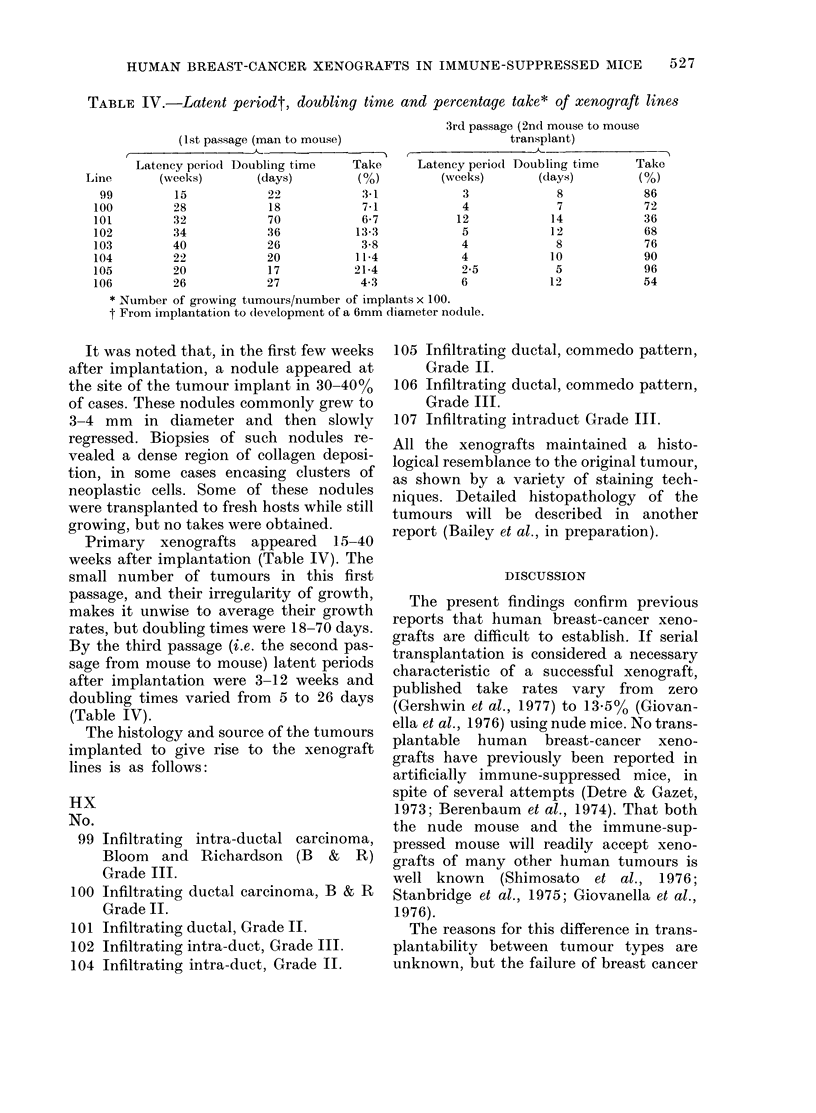
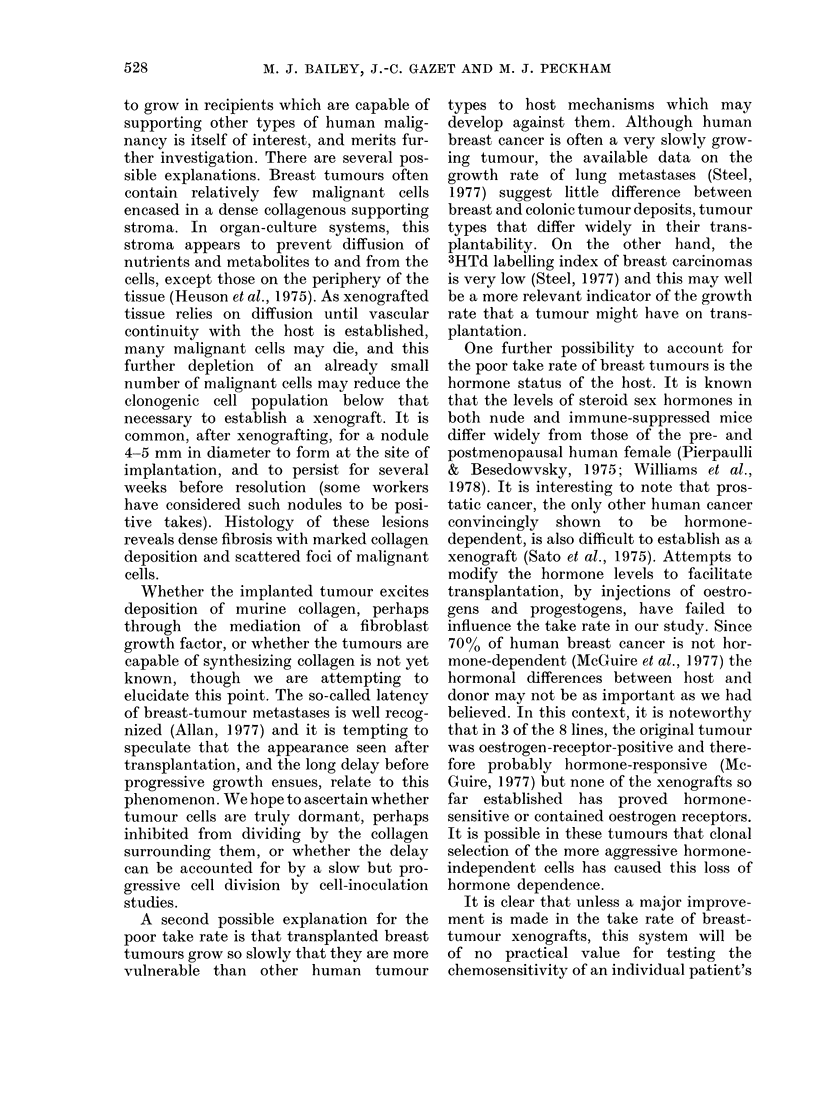
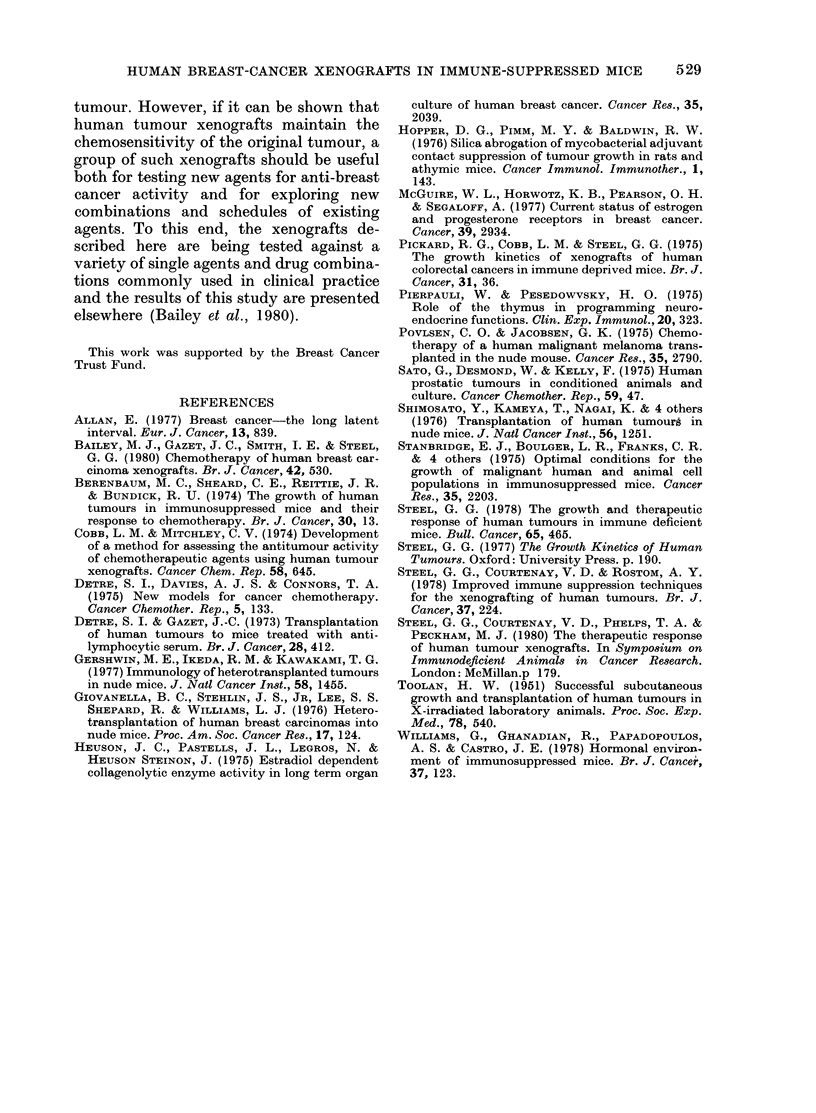
Selected References
These references are in PubMed. This may not be the complete list of references from this article.
- Allan E. Breast cancer: the long latent interval. Eur J Cancer. 1977 Aug;13(8):839–845. doi: 10.1016/0014-2964(77)90139-6. [DOI] [PubMed] [Google Scholar]
- Bailey M. J., Gazet J. C., Smith I. E., Steel G. G. Chemotherapy of human breast-carcinoma xenografts. Br J Cancer. 1980 Oct;42(4):530–536. doi: 10.1038/bjc.1980.276. [DOI] [PMC free article] [PubMed] [Google Scholar]
- Berenbaum M. C., Sheard C. E., Reittie J. R., Bundick R. V. The growth of human tumours in immunosuppressed mice and their response to chemotherapy. Br J Cancer. 1974 Jul;30(1):13–32. doi: 10.1038/bjc.1974.109. [DOI] [PMC free article] [PubMed] [Google Scholar]
- Cobb L. M., Mitchley B. C. Development of a method for assessing the antitumor activity of chemotherapeutic agents using human tumor xenografts. Cancer Chemother Rep. 1974 Sep-Oct;58(5 Pt 1):645–651. [PubMed] [Google Scholar]
- Detre S. I., Gazet J. C. Transplantation of human tumour to immune deprived mice treated with anti-thymocyte serum. Br J Cancer. 1973 Nov;28(5):412–416. doi: 10.1038/bjc.1973.166. [DOI] [PMC free article] [PubMed] [Google Scholar]
- Gershwin M. E., Ikeda R. M., Kawakami T. G., Owens R. B. Immunobiology of heterotransplanted human tumors in nude mice. J Natl Cancer Inst. 1977 May;58(5):1455–1461. doi: 10.1093/jnci/58.5.1455. [DOI] [PubMed] [Google Scholar]
- Heuson J. C., Pasteels J. L., Legros N., Heuson-Stiennon J., Leclercq G. Estradiol-dependent collagenolytic enzyme activity in long-term organ culture of human breast cancer. Cancer Res. 1975 Aug;35(8):2039–2048. [PubMed] [Google Scholar]
- McGuire W. L., Horwitz K. B., Pearson O. H., Segaloff A. Current status of estrogen and progesterone receptors in breast cancer. Cancer. 1977 Jun;39(6 Suppl):2934–2947. doi: 10.1002/1097-0142(197706)39:6<2934::aid-cncr2820390680>3.0.co;2-p. [DOI] [PubMed] [Google Scholar]
- Pickard R. G., Cobb L. M., Steel G. G. The growth kinetics of xenografts of human colorectal tumours in immune deprived mice. Br J Cancer. 1975 Jan;31(1):36–45. doi: 10.1038/bjc.1975.5. [DOI] [PMC free article] [PubMed] [Google Scholar]
- Pierpaoli W., Besedovsky H. O. Role of the thymus in programming of neuroendocrine functions. Clin Exp Immunol. 1975 May;20(2):323–338. [PMC free article] [PubMed] [Google Scholar]
- Povlsen C. O., Jacobsen G. K. Chemotherapy of a human malignant melanoma transplanted in the nude mouse. Cancer Res. 1975 Oct;35(10):2790–2796. [PubMed] [Google Scholar]
- Sato G., Desmond W., Kelly F. Human prostatic tumors in conditioned animals and culture. Cancer Chemother Rep. 1975 Jan-Feb;59(1):47–49. [PubMed] [Google Scholar]
- Shimosato Y., Kameya T., Nagai K., Hirohashi S., Koide T., Hayashi H., Nomura T. Transplantation of human tumors in nude mice. J Natl Cancer Inst. 1976 Jun;56(6):1251–1260. doi: 10.1093/jnci/56.6.1251. [DOI] [PubMed] [Google Scholar]
- Stanbredge E. J., Boulger L. R., Franks C. R., Garrett J. A., Reeson D. E., Bishop D., Perkins F. T. Optimal conditions for the growth of malignant human and animal cell populations in immunosuppressed mice. Cancer Res. 1975 Aug;35(8):2203–2212. [PubMed] [Google Scholar]
- Steel G. G., Courtenay V. D., Rostom A. Y. Improved immune-suppression techniques for the exongrafting of human tumours. Br J Cancer. 1978 Feb;37(2):224–230. doi: 10.1038/bjc.1978.30. [DOI] [PMC free article] [PubMed] [Google Scholar]
- Steel G. G. The growth and therapeutic response of human tumours in immune deficient mice. Bull Cancer. 1978;65(4):465–472. [PubMed] [Google Scholar]
- Williams G., Ghanadian R., Papadopoulos A. S., Castro J. E. Hormonal environment of immunosuppressed mice. Br J Cancer. 1978 Jan;37(1):123–125. doi: 10.1038/bjc.1978.17. [DOI] [PMC free article] [PubMed] [Google Scholar]


